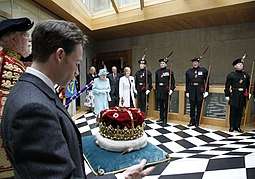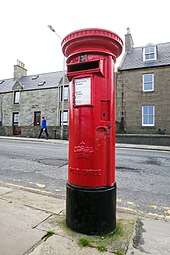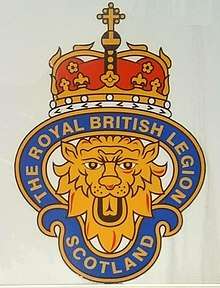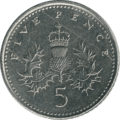Crown of Scotland
The Crown of Scotland is the crown that was used at the coronation of the monarchs of Scotland. Remade in its current form for King James V of Scotland in 1540, the crown is part of the Honours of Scotland, the oldest surviving set of Crown jewels in the British Isles. The crown dates from at least 1503 when, in an earlier form, it was depicted in the portrait of James IV of Scotland in the Book of Hours commissioned for his marriage to Margaret Tudor.
| Crown of Scotland | |
|---|---|
 Crown of Scotland | |
| Details | |
| Country | Scotland |
| Made | 1540 (current version) |
| Owner | Queen Elizabeth II as Monarch of the United Kingdom |
| Weight | 1.64 kg (3.6 lb) |
| Arches | 2 |
| Material | Scottish gold[1] |
| Predecessors | Pre-1540 example remade to current version. |
Manufacture
In January 1540, King James V commissioned the royal goldsmith, John Mosman, to refashion the Crown of Scotland. The existing crown was delicate and had been repaired at least twice in the previous 30 years, and a 1539 inventory showed further damage, including the loss of one fleur-de-lis. Mosman dismantled the old crown and removed its stones and pearls. The crown was melted down and Mosman added 41 ounces of gold mined at Crawford Moor in Lanarkshire.
Constructed of solid gold, the crown consists of a base, with four fleur-de-lis alternating with four strawberry leaves. The four arches of the crown are decorated with gold and red oak leaves. At the intersection of the arches is a golden monde, painted blue with gold stars. The monde is surmounted by a large cross decorated in gold and black enamel and pearls. The crown is encrusted with 22 gemstones, including garnets and amethysts, 20 precious stones and 68 Scottish freshwater pearls.
James V ordered a purple and ermine bonnet from tailor Thomas Arthur of Edinburgh to fit inside the crown. James VII ordered the colour of the bonnet be changed to red. The bonnet had to be replaced several times, and the present bonnet was made in 1993. The completed crown weighs 1.64 kg (3 lb 10 oz).
Usage
.svg.png)
The crown was first worn in the year of its manufacture by James V to the coronation at Holyrood Abbey of his second wife, Mary of Guise, as queen consort. It was subsequently used in the coronations of the child monarchs Mary I in 1543 and James VI in 1567.
In the absence of a resident Scottish monarch following the Union of the Crowns in 1603, (on James VI inheriting the thrones of England and Ireland the Royal Household relocated from Edinburgh to London), the Honours were carried to sittings of the Parliament of Scotland to symbolise the sovereign's presence and the Royal Assent to legislation.
The crown was used for the Scottish coronations of both Charles I in 1633 and Charles II in 1651. However, no subsequent monarchs of Scotland were crowned using this crown.
During the Civil War, having already destroyed the ancient English Crown Jewels, Oliver Cromwell sought to destroy the Scottish Crown Jewels. However, the Honours were secretly buried until the monarchy was restored in 1660.
Following the Act of Union of 1707, which unified the Kingdom of Scotland and the Kingdom of England to form the Kingdom of Great Britain, and having no ceremonial role to play in the proceedings of the new Parliament of Great Britain in London, the Honours were locked away in Edinburgh Castle. There they remained all but forgotten in a chest until 1818, when a group of people including Sir Walter Scott set out to find them. Since 1819 they have been on display in the Crown Room of Edinburgh Castle from where they are removed only for state occasions. The first was when presented to King George IV, at the Palace of Holyroodhouse in 1822, during his visit to Scotland (the first visit to Scotland by a reigning monarch since 1651).
On 24 June 1953, following her coronation at Westminster Abbey, the crown was carried before Queen Elizabeth II in a procession from the Palace of Holyroodhouse to the High Kirk of St Giles, Edinburgh, where the Honours of Scotland, including the crown, were presented to The Queen during a National Service of Thanksgiving.
More recently, the crown has been present at the official opening ceremonies of sessions of the Scottish Parliament, including the first in 1999[2] and the official opening of the new Scottish Parliament Building in 2004.[3] On such occasions the crown, carried by the Duke of Hamilton, the hereditary bearer of the Crown of Scotland, immediately precedes Her Majesty The Queen in the custom of the ancient opening ceremonial procession known as the Riding of Parliament.
Appearance in Heraldry
.svg.png)
As well as appearing in the Royal coat of arms of the UK used in Scotland and Scottish versions of the Royal Cypher, the crown appears in the version of the UK royal arms used by the Scotland Office, and also appeared in the arms used by the former Scottish Executive.
Appearance elsewhere
Stylised versions of the crown appear upon the badges of the Royal Regiment of Scotland, The Royal British Legion Scotland, the Scottish Ambulance Service, Police Scotland and, (As part of the Crest of the Royal Arms), upon the logos of the Crown Office and Procurator Fiscal Service, RCAHMS, and General Register Office for Scotland.
A version of the crown is used upon Royal Mail premises, vehicles and Scottish pillar, lamp and wall boxes, and a metal insert plate showing the Crown of Scotland also appears on model K6 red telephone boxes in Scotland.
From 1927 until its abolition in 1975, the arms of Kincardineshire County Council featured the crown, together with the sword and sceptre, above an artist's rendering of Dunnottar Castle, to mark the county's status as the 17th century hiding place of the Honours of Scotland during the Wars of the Three Kingdoms.[4]
The Crown of Scotland also appears on maritime flags, including the Blue Ensign of vessels belonging to Marine Scotland, (Compliance Division), and also upon the burgees of certain Royal yacht clubs in Scotland including, for example, that of the Royal Scottish Motor Yacht Club.[5]
From 1968 to 2008, the reverse of the Five pence coin, minted for circulation throughout the United Kingdom, featured the Royal Badge of Scotland; a thistle surmounted by the Crown of Scotland.
The crown, as a component of the Royal Badge of Scotland, (A Thistle Royally Crowned), appeared on a 'Regional' series of definitive, pre-decimal Royal Mail stamps, during the period 1958 to 1970.
In 2003 a new crown was made for the Lord Lyon, modelled on the Crown of Scotland.[6] This crown has removable arches (like one of the late Queen Mother's crowns) which will be removed at coronations to avoid any hint of lèse majesté.[7]
Gallery
 A representation of the Crown of Scotland found on cast iron Royal Mail pillar boxes, lamp boxes and wall boxes in Scotland
A representation of the Crown of Scotland found on cast iron Royal Mail pillar boxes, lamp boxes and wall boxes in Scotland.jpg) Post mounted Royal Mail lamp box in Killearn, Stirlingshire, showing the Crown of Scotland in place of the St Edward's Crown/EIIR cypher
Post mounted Royal Mail lamp box in Killearn, Stirlingshire, showing the Crown of Scotland in place of the St Edward's Crown/EIIR cypher.jpg) Royal Mail lamp box (type LB3426) showing the Crown of Scotland on a steel plate
Royal Mail lamp box (type LB3426) showing the Crown of Scotland on a steel plate.jpg)

.jpg) 1958-1970 Pre-decimal definitive Royal Mail stamp, featuring the Crown of Scotland in the Royal Badge of Scotland: A Thistle Royally Crowned
1958-1970 Pre-decimal definitive Royal Mail stamp, featuring the Crown of Scotland in the Royal Badge of Scotland: A Thistle Royally Crowned.jpg) Royal Mail vehicle logo as used in Scotland, showing the Crown of Scotland in place of the St Edward's Crown used elsewhere
Royal Mail vehicle logo as used in Scotland, showing the Crown of Scotland in place of the St Edward's Crown used elsewhere.jpg) A Royal Mail vehicle logo used in Scotland showing a simplified version of the Crown of Scotland. (A convention adopted after the 1953 Coronation prevents EIIR being used in Scotland)[8]
A Royal Mail vehicle logo used in Scotland showing a simplified version of the Crown of Scotland. (A convention adopted after the 1953 Coronation prevents EIIR being used in Scotland)[8].jpg) Red telephone box (Model K6), converted to house a defibrillator, showing the Crown of Scotland on an insert plate, (A plate showing St Edward's Crown was inserted on K6 models outwith Scotland).
Red telephone box (Model K6), converted to house a defibrillator, showing the Crown of Scotland on an insert plate, (A plate showing St Edward's Crown was inserted on K6 models outwith Scotland). Carved version of the Honours of Scotland which denotes the Royal Pew at the Kirk of the Canongate, Edinburgh.
Carved version of the Honours of Scotland which denotes the Royal Pew at the Kirk of the Canongate, Edinburgh..jpg) The Crown of Scotland is incorporated into the badge of the Scottish Ambulance Service, shown here on the tail of a Eurocopter EC135.
The Crown of Scotland is incorporated into the badge of the Scottish Ambulance Service, shown here on the tail of a Eurocopter EC135. The Royal Regiment of Scotland includes the Crown of Scotland in its badge, shown here on the blanket of the regiment's Shetland Pony mascot.
The Royal Regiment of Scotland includes the Crown of Scotland in its badge, shown here on the blanket of the regiment's Shetland Pony mascot..jpg) Police Scotland vehicle decal (Bilingual: English/Gaelic) showing a stylised version of the Royal Badge of Scotland: A thistle surmounted by the Crown of Scotland.
Police Scotland vehicle decal (Bilingual: English/Gaelic) showing a stylised version of the Royal Badge of Scotland: A thistle surmounted by the Crown of Scotland. The badge of the Royal British Legion Scotland showing the Crown of Scotland.
The badge of the Royal British Legion Scotland showing the Crown of Scotland..svg.png) Royal coat of arms of the United Kingdom used in Scotland by the British Government, (Scotland Office), rendered in full colour. The Crown of Scotland surmounts the escutcheon and both supporters.
Royal coat of arms of the United Kingdom used in Scotland by the British Government, (Scotland Office), rendered in full colour. The Crown of Scotland surmounts the escutcheon and both supporters. Marine Scotland's ensign; A blue ensign defaced by an anchor and chain, accompanied by silver letters SF (Scottish Fisheries), within a thistle wreath and surmounted by the Crown of Scotland.
Marine Scotland's ensign; A blue ensign defaced by an anchor and chain, accompanied by silver letters SF (Scottish Fisheries), within a thistle wreath and surmounted by the Crown of Scotland. Crest of the (historic) Royal Arms of Scotland and of the Royal Arms of the UK used in Scotland; the lion of the King of Scots atop the Crown of Scotland, bearing the Honours of Scotland. Motto: IN DEFENS
Crest of the (historic) Royal Arms of Scotland and of the Royal Arms of the UK used in Scotland; the lion of the King of Scots atop the Crown of Scotland, bearing the Honours of Scotland. Motto: IN DEFENS The reverse of a Five pence (British coin) showing the Crown of Scotland as a component of the Royal Badge of Scotland: A Thistle Royally Crowned.
The reverse of a Five pence (British coin) showing the Crown of Scotland as a component of the Royal Badge of Scotland: A Thistle Royally Crowned.
References
- The Honours of Scotland
- The Scottish Parliament Parliamentary News Release Archived 21 June 2009 at the Wayback Machine
- The Scottish Parliament Media Briefing Note Archived 19 May 2006 at the Wayback Machine
- The Coat of Arms of Kincardineshire
- The Royal Scottish Motor Yacht Club
- "Lord Lyon gets his crown back". The Scotsman. 13 July 2003. Retrieved 25 February 2018.
- "Queen Elizabeth II and Scotland". National Records of Scotland. NRS. Retrieved 24 July 2019.
See also
![]()
.svg.png)